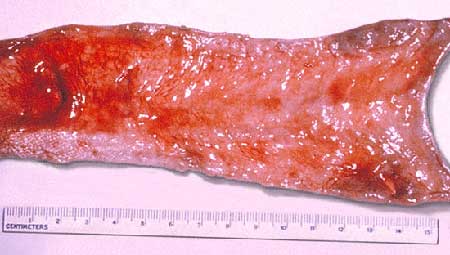Complications
Antimicrobial resistance is increasing, especially in the Indian subcontinent.
A sudden worsening of the abdominal pain or rectal bleeding should suggest bowel perforation.[Figure caption and citation for the preceding image starts]: Typhoid fever cholecystitis with an ulceration and perforation of the gallbladder into the jejunumCDC/Armed Forces Institute of Pathology, Charles N. Farmer; used with permission [Citation ends].
The more serious complications, such as gastrointestinal bleeding and intestinal perforation, may occur in 10% to 15% of patients in endemic countries, usually after the second week of infection.
These complications are rarely seen in travelers, probably because of early access to medical care.
In case of bowel perforation, surgery is the treatment of choice. The optimal method of surgical management, including simple closure versus segmental bowel resection, and primary closure versus delayed primary closure, remains controversial.[88][89] Mortality in the surgical management of typhoid perforation has declined in many countries over the past 50 years, from 50% to single figures, due to surgical advances and improved supportive care.[90]
Sepsis due to enteric fever is rarely described in neonates. Clinical manifestations in infants range from asymptomatic infection to life-threatening disease. Thus, Salmonella infections should be considered in the differential diagnosis of sepsis neonatorum, especially in endemic areas.[93]
Death is more common in populations in endemic areas (up to 30%) and in immigrants, but rare in short-term travelers.[94]
Chronic biliary carriage may occur in 2% to 5% of patients even after treatment. Biliary carriage is defined as continued shedding of the organism for more than 1 year and carriers are a public health risk, especially those who are in the food service industry.
Extraintestinal manifestations may also occur. These include central nervous system involvement (3%-35%), pulmonary involvement (1%-86%), bone and joints (≤1%), and genitourinary system involvement (<1%). Cardiovascular complications occur in 1% to 5% of cases and include ECG changes, myocarditis, and endocarditis as the main complications. Less commonly, pericarditis and arteritis can occur.[91] These complications are usually reported from populations where typhoid is endemic, and where timely access to appropriate medical care might be lacking. In travelers to endemic areas these complications are rarely reported, although reported cases include that of near-fatal myocarditis.[92]
Use of this content is subject to our disclaimer